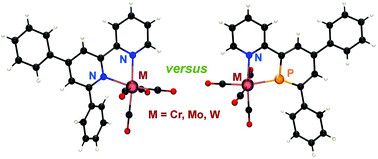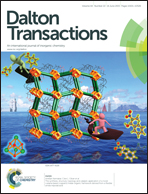2-(2′-Pyridyl)-4,6-diphenylphosphinine versus 2-(2′-pyridyl)-4,6-diphenylpyridine: synthesis and characterization of novel Cr0, Mo0 and W0 carbonyl complexes containing chelating P,N and N,N ligands†
Abstract
Replacing nitrogen by phosphorus in otherwise similar structures changes the properties of the resulting compounds significantly due to the electronic differences that exist between these heteroatoms. While the “hard” nitrogen atom of the pyridine moiety acts as a good σ-donor, the “soft” phosphorus atom of the phosphinine core results in a rather strong π-acceptor capacity. A series of novel group 6 complexes [M(CO)4(L^L)] (M = Cr0, Mo0, W0) have been synthesized, in which L^L is either 2-(2′-pyridyl)-4,6-diphenylphosphinine (P,N) or the corresponding bipyridine derivative, 2-(2′-pyridyl)-4,6-diphenylpyridine (N,N) as a chelating, bidentate ligand. The here presented results describe a detailed investigation of the structural and spectroscopic properties of the coordination compounds [M(CO)4(P,N)] and [M(CO)4(N,N)] (M = Cr0, Mo0, W0), leading to a better understanding of such intriguing aromatic phosphorus heterocycles.


 Please wait while we load your content...
Please wait while we load your content...